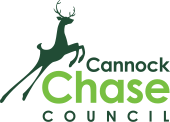|
Cannock Chase District
Cannock Chase is a local government district in Staffordshire, England. It is named after and covers a large part of Cannock Chase, a designated National Landscape. The council is based in the town of Cannock. The district also contains the towns of Hednesford and Rugeley, as well as a number of villages and surrounding rural areas. The district borders South Staffordshire to the west, the Borough of Stafford to the north, Lichfield District to the east, and the Metropolitan Borough of Walsall to the south. HistoryThe district was created on 1 April 1974 under the Local Government Act 1972, covering two former districts plus a single parish from a third, which were all abolished at the same time:[3]
The new district was named Cannock Chase after the landscape and former royal forest which covers much of the area.[4] Governance
Cannock Chase District Council, which styles itself "Cannock Chase Council", provides district-level services. County-level services are provided by Staffordshire County Council. Much of the district is also covered by civil parishes, which form a third tier of local government.[6][7] The council's logo is a deer, referencing the area's past as a royal hunting forest and the fact that deer are common in the area. A survey in 2022 found that the deer population was growing.[8] Political controlThe council has been under Labour majority control since the 2024 election.[9] The first elections to the council were held in 1973, initially operating as a shadow authority alongside the outgoing authorities before coming into its powers on 1 April 1974. Political control of the council since 1974 has been as follows:[10][11]
LeadershipThe leaders of the council since 2005 have been:[12]
CompositionFollowing the 2024 election the composition of the council is:[14]
The next election is due in May 2026.[15] ElectionsSince the last boundary changes took effect in 2024, the council has comprised 36 councillors representing 12 wards, with each ward electing three councillors. Elections are held three years out of every four, with a third of the council (one councillor for each ward) elected each time for a four-year term of office. Staffordshire County Council elections are held in the fourth year of the cycle when there are no district council elections.[16] The district covers the same area as the Cannock Chase (UK Parliament constituency). Until the 2010 general election the constituency also included the adjacent village of Huntington in South Staffordshire. From 2010 onwards the constituency has exactly the same boundaries as the district.[7] PremisesThe council is based at the Civic Centre on Beecroft Road in Cannock.[17] The building was purpose-built for the council between 1978 and 1981.[18] DemographyAccording to data from the 2011 United Kingdom census, Cannock Chase has a population of 100,600, with 49,500 males and 51,100 females. 62.5% of the population is between the ages of 16–64, of which 88.7% is economically active, 11.2% above the West Midlands regional average.[19] MediaIn terms of television, the area is served by BBC West Midlands and ITV Central (West) broadcasting from Birmingham. Television signals are received the Sutton Coldfield TV transmitter. [20] Radio stations for the area are:
The Express & Star is the local newspaper that cover the district. [22] Towns and parishesMuch of the district is covered by eight civil parishes. The exception is certain parts of Cannock, which are unparished.[7] The parish councils for Hednesford and Rugeley have declared their parishes to be towns, allowing them to take the style "town council".[23] When the district was created in 1974 it only contained one parish, being Brindley Heath; the former Rugeley Urban District and Cannock Urban District were both unparished. In 1988 two parishes called Rugeley and Brereton were created covering the former Rugeley Urban District, and four parishes called Bridgtown, Cannock Wood, Heath Hayes and Wimblebury, and Norton Canes were created covering parts of the former Cannock Urban District.[24] The parish of Hednesford was subsequently created in 2000 from another part of the former Cannock Urban District.[25] The parishes are: Other areas and settlements include: References
Further reading |
||||||||||||||||||||||||||||||||||||||||||||||||||||||||||||||||||||||||||||||||||||||||||||||||||||||||||||||||||||||||||||||||||||||||||||||||||||||||||||||||||||||||||||





